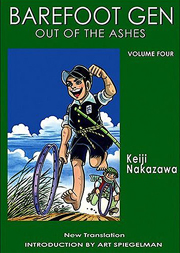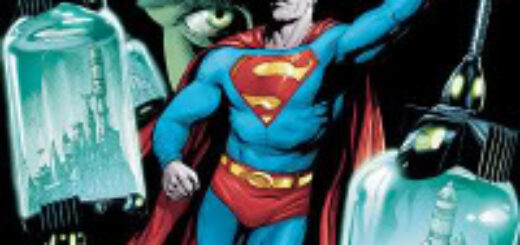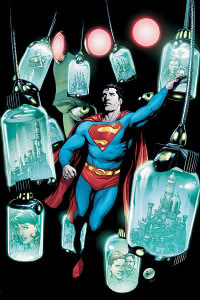Interview: Neil Kleid on ‘Worlds of Dungeons and Dragons’
 Writer and Xeric Grant winner Neil Kleid has come a long way since he wrote his award-winning improvised comic Ninety Candles. Since that time, he’s managed to have a diverse and interesting writing career tackling various comic book titles such as G.I. Joe and X-Men Unlimited.
Writer and Xeric Grant winner Neil Kleid has come a long way since he wrote his award-winning improvised comic Ninety Candles. Since that time, he’s managed to have a diverse and interesting writing career tackling various comic book titles such as G.I. Joe and X-Men Unlimited.
Recently, he’s signed on to help bring Devil’s Due Publishing’s upcoming series The Worlds of Dungeons & Dragons to eager comics fans. ComicMix caught up with the busy author to get the latest info on Worlds of Dungeons & Dragons, his other upcoming projects and his love of axes.
COMICMIX: How much did you know about Dungeons & Dragons before you started writing the comic book? Did you ever play the game growing up?
NEIL KLEID: Once or twice, as a kid. I was mostly into the Bard’s Tale videogame and the early Dragonlance books. When I did play, I was always a dwarf. I liked the axes.
I’d stopped reading the DL books years ago, but my pal Andrew Dabb’s been adapting them for Devil’s Due for a while now and so, to check out his work, I’d flip through them at the store and I kind of got hooked again. I’m mostly into the books that focus on the characters from the War of the Lance.
CMix: What attracts you to a project like Worlds of Dungeons & Dragons in the first place?
NK: Intriguing characters, creepy monsters, short, condensed stories. Also, free rein and choice. Good editors. Stories I liked when I was younger that strike a chord inside.
CMix: How did this project first come about and how did you get involved?
NK: I’d been talking to the folks at Devil’s Due for a while now, trying to set something up with them – specifically with the G.I. Joe license. I had a meeting with former editor Mark Powers a few years
back and then traded several emails with current editor Mike O’ Sullivan. We always talked about the possibility of doing something together.
Then, Dabb mentioned they were looking for new D&D writers just as Mike emailed asking if it was something I’d be interested in. He hooked me up with editor James Lowder and we ran through the types of stories I wanted to do, narrowing it down to "The Legacy." It’s been a lot of fun so far.
CMix: This is your first time doing something in the sword-and-sorcery genre, right? This comic seems like new territory for you based on your previous work.


 As I begin to type this, on a rainy Sunday afternoon, there are only 211 days left before someone else lives at 1600 Pennsylvania Avenue, near the Potomac. I tell you this, not because it has anything to do with what follows, but to perhaps lend a note of cheer to your hour.
As I begin to type this, on a rainy Sunday afternoon, there are only 211 days left before someone else lives at 1600 Pennsylvania Avenue, near the Potomac. I tell you this, not because it has anything to do with what follows, but to perhaps lend a note of cheer to your hour. The Costume Institute of the Metropolitan Museum of Art set aside Sunday, June 22, for a day of panel discussions about superheroes, the people who create them, and what they wear.
The Costume Institute of the Metropolitan Museum of Art set aside Sunday, June 22, for a day of panel discussions about superheroes, the people who create them, and what they wear.  Hello there, folks. So the first issue of DC’s latest mega-event,
Hello there, folks. So the first issue of DC’s latest mega-event,  I don’t know when I first saw an English edition of Barefoot Gen. It was probably sometime in the mid 70s, when I was editing for the modest enterprise that has become the mighty Marvel Entertainment. In those days, a lot of stuff crossed editorial desks and we read most of it, if not all. So: Japanese comics? Sure, I’ll give it a look. It was probably my first experience with manga and I remember feeling a mild taste of cognitive dissonance – a perceived disconnect between subject and form. (I am choosing to ignore, because it’s a bit off-subject, the hybrid of cartooning and illustration that’s most superhero art.)
I don’t know when I first saw an English edition of Barefoot Gen. It was probably sometime in the mid 70s, when I was editing for the modest enterprise that has become the mighty Marvel Entertainment. In those days, a lot of stuff crossed editorial desks and we read most of it, if not all. So: Japanese comics? Sure, I’ll give it a look. It was probably my first experience with manga and I remember feeling a mild taste of cognitive dissonance – a perceived disconnect between subject and form. (I am choosing to ignore, because it’s a bit off-subject, the hybrid of cartooning and illustration that’s most superhero art.) Born on Governors Island, Manhattan, New York in 1941, Neal Adams attended High School Industrial Art in Manhattan and then went to work in the advertising industry. He had actually applied to work at DC Comics but didn’t get a job offer — Adams did do some freelance work drawing Bat Masterson and Archie Comics but was not credited for it. In 1962 he was hired as an assistant at the Newspaper Enterprise Association (NEA), and worked anonymously on several comic strips before being given his own strip, Ben Casey.
Born on Governors Island, Manhattan, New York in 1941, Neal Adams attended High School Industrial Art in Manhattan and then went to work in the advertising industry. He had actually applied to work at DC Comics but didn’t get a job offer — Adams did do some freelance work drawing Bat Masterson and Archie Comics but was not credited for it. In 1962 he was hired as an assistant at the Newspaper Enterprise Association (NEA), and worked anonymously on several comic strips before being given his own strip, Ben Casey. Something of a preamble, here, so sit tight and now dig this: The comics-censorship ruckus of the post-WWII years had begun to peter out, if only just, as the phobic 1950s gave way to the larger struggles – expression vs. repression, in the long wake of the Depression – of the presumably more free-wheeling 1960s. All were rooted in a popular urge to embrace the freedoms that the close of World War II was supposed to have heralded; a contrary urge to confine such freedoms to a privileged few was as intense, if not necessarily as popularly widespread.
Something of a preamble, here, so sit tight and now dig this: The comics-censorship ruckus of the post-WWII years had begun to peter out, if only just, as the phobic 1950s gave way to the larger struggles – expression vs. repression, in the long wake of the Depression – of the presumably more free-wheeling 1960s. All were rooted in a popular urge to embrace the freedoms that the close of World War II was supposed to have heralded; a contrary urge to confine such freedoms to a privileged few was as intense, if not necessarily as popularly widespread. Born in Brooklyn, New York in 1955, Paul Kupperberg got his start in comic fandom. He and Paul Levitz produced the comics fanzine The Comic Reader from 1971 to 1973, and Etcetera from 1972 to 1973. In 1975 Kupperberg sold several short horror stories to Charlton Comics, and then a few months later sold a World of Krypton story to DC for their Superman Family comic. He has written for many other DC comics since then, including Superman, Doom Patrol, Green Lantern, Justice League of America. He created the series Arion: Lord of Atlantis, Checkmate, and Takion.
Born in Brooklyn, New York in 1955, Paul Kupperberg got his start in comic fandom. He and Paul Levitz produced the comics fanzine The Comic Reader from 1971 to 1973, and Etcetera from 1972 to 1973. In 1975 Kupperberg sold several short horror stories to Charlton Comics, and then a few months later sold a World of Krypton story to DC for their Superman Family comic. He has written for many other DC comics since then, including Superman, Doom Patrol, Green Lantern, Justice League of America. He created the series Arion: Lord of Atlantis, Checkmate, and Takion.
 Book of the Week:
Book of the Week:  Writer Geoff Johns is best known for re-imagining some of the most beloved heroes in the history of the DCU.
Writer Geoff Johns is best known for re-imagining some of the most beloved heroes in the history of the DCU.








